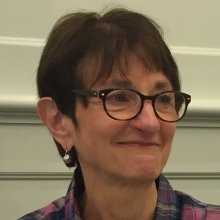Seeing the Impact of Change and Collaboration at Brotherhood Synagogue Nursery School
Site Visit Journal | Seeing Change Happen Reflection
Susan Remick Topek
Seeing change happen...
I feel privileged to have been an observer of Brotherhood Synagogue Nursery School, Gramercy Park, NYC, for the past several years. I have come in to see the teachers, speak with them on issues of professional development and watch how they have grown and journeyed towards a Reggio-inspired vision.
My past interactions with them made our In-Site-Ful Journey visit to the school in December, 2016, a very meaningful experience for me. I was able to see beautiful rooms in what they contained and how much was displayed. I was able to notice what had been added, what was eliminated and how the staff as a whole had become a new and deeply connected community. I give Merril Feinstein, the school’s Director, much credit for putting her faith in the leadership and vision of her faculty. She included them in every step along the change-path. She believed in the direction of the school, but also understood that she could not make important changes without the buy-in and ownership of her staff. The result is a true community of practice among the staff with a focus on collaboration and connection to values, both constructivist and Jewish.
Principles of learning
During our visit Merril mentioned an influential book in her journey, Mind in the Making by Ellen Galinsky. The book outlines seven essential life skills for children’s learning:
- Focus and Self Control
- Perspective Taking
- Communicating
- Making Connections
- Critical Thinking
- Taking on Challenges
- Self-Directed, Engaged Learning
After visiting Merril’s school and seeing the teachers and children at play and in classroom experiences and activities, the seven skills are not only visible in the learning of the children, but in the interaction and intentionality of the educators.
Others are inspired to take their own first steps
A few days after our visit, I received an email from Zoey Saacks, Director, Chai Center Preschool, Dix Hills, NY. She returned to her school and said:
“I have spent the last two days simplifying our environment after our wonderful visit on Wednesday. The reaction in the morning from many of the students was “we are bored!!” By the afternoon they were busier and more engaged than ever before!!
Less is more and what I see from this is another lesson in believing in the child. With minimal items they have created a whole world. They are engaging with materials that have been in their classroom the entire year but were not that inviting compared to the easier manipulatives, etc. that take less brain power as the toy creator did most of the thinking for them!”

Change doesn’t happen in a bubble. Therefore, after our Insiteful Journey visits we ask educators to share their impressions and reflections with colleagues and with the parents of their students. To the parents we encourage educators to say something like, I was absent today because I was visiting a school for my professional development and this is what I am able to now bring to your children because of it.
Geula Zamist, Director, Congregation Agudath Israel, Highland Park, NJ, who sent teachers from her school to the Brotherhood visit, sent me an email after the visit saying:
“…I wanted to share the beautiful enthusiastic response my teacher Jane Gladstein had to the Insiteful Journey visit to Brotherhood. She was so impressed that she shared this letter with the parents in her class!”

One of the perks of being on the staff at CAI Nursery School is we are encouraged to visit other Nursery Schools to view best practice. Last Wednesday I visited the Brotherhood Synagogue in Gramercy Park, a community housed in a protected, historic Quaker meeting house right on the park. The school is in the basement of this very old building, but it is beautiful. There are old brickwork arches and a feeling of history. The school itself is Reggio inspired. Our school has been on a journey visiting, reading and learning about this philosophy of pre-school education, and this school is a wonderful example.
Reggio inspired means the classrooms are filled with lots of natural materials and lots of child-driven learning. The classrooms themselves were minimally equipped; most of the “teaching tools” were housed outside of the classrooms in a communal cabinet, available to teachers and children when they chose. In the classroom the children were wonderfully busy imagining and learning. One class was involved in a study of a very New York topic….skyscrapers. There were models and drawings and stories. Another class was rolling sugar cookies and cutting them into Chanukah shapes. Everyone was spinning dreidels and graphing the results. Classes had minimal toys to encourage imagination and investigation and to focus the children’s attention. On a rainy day, everyone including the twos went out to play. There was a lot of splashing and joy.
What did I take away from this visit? I learned less is truly more. With less distraction the children are able to explore what they are interested in more deeply. This empowers them and builds their confidence as explorers and learners. What greater gift can we give them? Of course, I am not throwing out all our toys, although that was my first thought! We will start with little steps. We will try to take one area of the room and simplify it, and take it from there.
Merril reminded the participating educators to ask themselves three questions upon setting up learning experiences: What are you teaching? What is it good for? How do you know? Merril and her faculty at Brotherhood Synagogue shared the story of their journey and provoked others to take steps along that path – with their school as strong and inspiring model to look to as they continue on.
Click to see pictures of this inspiring school visit.